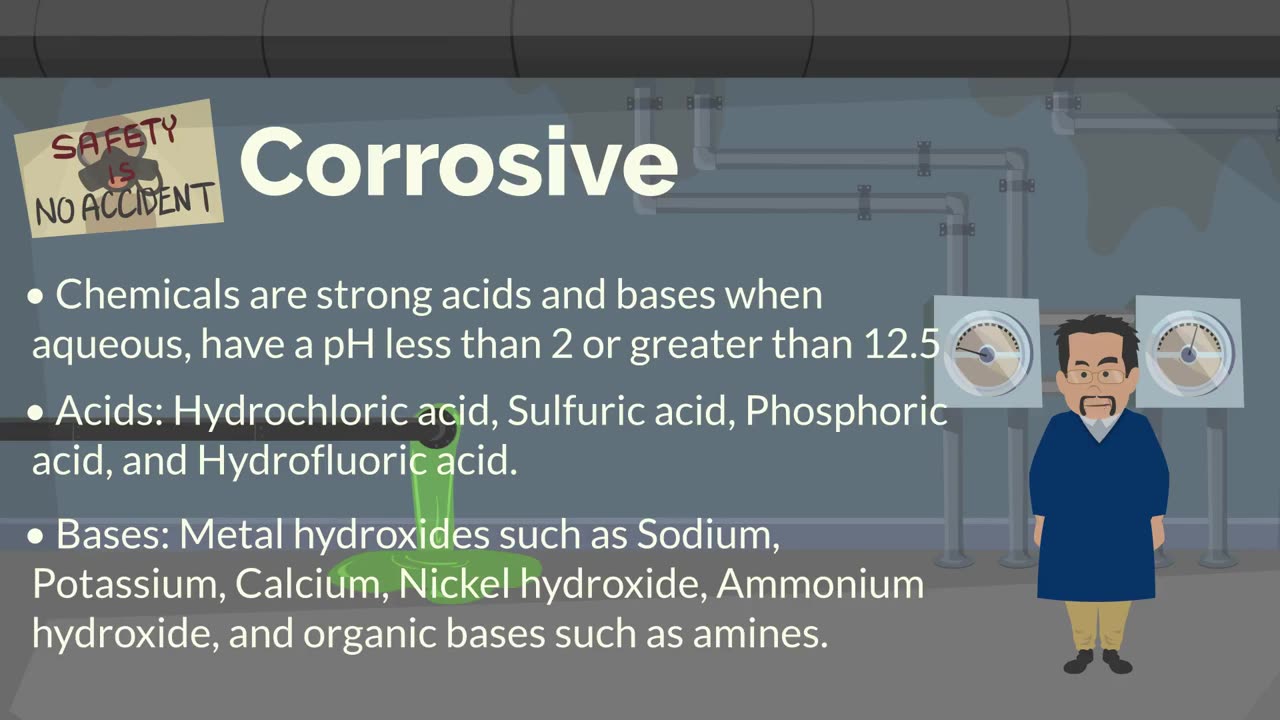Premium Only Content

Chemical Hazard Recognition_ TRIC
**Chemical Hazard Recognition: TRIC**
The acronym **TRIC** can be used as a systematic approach to recognize and address chemical hazards. It stands for **Toxicity, Reactivity, Ignitability, and Corrosivity**. Here's how each component helps in chemical hazard recognition:
---
### **1. Toxicity**
- **Definition**: The potential of a chemical to cause harm to living organisms through inhalation, ingestion, or skin contact.
- **Indicators**:
- Pictograms or labels indicating "Toxic," "Harmful," or "Dangerous."
- Consult the Safety Data Sheet (SDS) for information on lethal doses (LD50) and permissible exposure limits (PEL).
- **Recognition**:
- Examples: Carbon monoxide, cyanide, and pesticides.
- Observe symptoms like dizziness, nausea, or irritation.
---
### **2. Reactivity**
- **Definition**: The chemical's tendency to react violently or release energy when exposed to certain conditions (e.g., heat, water, or other chemicals).
- **Indicators**:
- Terms like "Unstable," "Explosive," or "Reactive" on labels.
- SDS section on stability and reactivity.
- **Recognition**:
- Examples: Sodium reacts with water; peroxides are shock-sensitive.
- Look for storage warnings like "Keep away from heat or incompatible substances."
---
### **3. Ignitability**
- **Definition**: The ability of a chemical to catch fire under certain conditions.
- **Indicators**:
- Flashpoint data on the SDS.
- Flammable or combustible warnings.
- Pictograms like the flame symbol.
- **Recognition**:
- Examples: Gasoline, ethanol, and acetone.
- Check for proper grounding and storage in fire-safe cabinets.
---
### **4. Corrosivity**
- **Definition**: The ability of a chemical to destroy or irreversibly damage materials, including skin and metals.
- **Indicators**:
- Pictograms or warnings indicating "Corrosive."
- SDS sections on handling precautions.
- **Recognition**:
- Examples: Sulfuric acid, sodium hydroxide, and hydrochloric acid.
- Observe physical signs of damage to containers or PPE.
---
### **Application of TRIC in Safety**
1. **Assessment**: Use TRIC to evaluate the potential risks of chemicals during storage, transportation, and usage.
2. **Training**: Educate employees about recognizing hazards and understanding labels and SDS.
3. **Controls**: Implement engineering controls (e.g., fume hoods), administrative controls (e.g., safe work practices), and PPE to mitigate risks.
Would you like this concept expanded into a training presentation or animation script?
-
 7:58
7:58
HSESafetyInformation
7 months agoAuthentic Peshawari Rosh _ Namkeen Gosht Recipe __ Traditional KPK and Baluchistan
701 -
 1:59:20
1:59:20
The Quartering
6 hours agoCharlie Kirk Conspiracies Go TOO FAR, Youtube Re-Bans Everyone & Libs Dying From Tylenol
134K78 -
 DVR
DVR
The Trish Regan Show
3 hours agoTrump SUES Disney Over Kimmel’s Return to ABC! Disney CEO, Kimmel BOTH OUT!?!
10K5 -
 1:07:22
1:07:22
Dr. Drew
5 hours agoTargeted: Political Violence Began Long Before Charlie Kirk's Assassination – Leftist Influencers Like Hasan Piker Are Making It Worse w/ Dave Rubin & Jack Posobiec – Ask Dr. Drew
14.7K1 -
 1:19:08
1:19:08
TheSaltyCracker
3 hours agoSaltCast 9-25-25
36.9K84 -
 LIVE
LIVE
StoneMountain64
3 hours agoBattlefield 6 News and Extraction Gaming
133 watching -
 24:15
24:15
Stephen Gardner
2 hours agoCharlie Kirk Bombshell: Fresh Video Footage Shatters the Narrative!😱
30.2K110 -
 9:51
9:51
Silver Dragons
3 hours agoSILVER PRICE SOARING - Is Silver In the END GAME Now?
20.9K4 -
 1:28:13
1:28:13
Russell Brand
5 hours agoThe Truth About UK Corruption – Andrew Bridgen Speaks Out - SF640
174K48 -
 2:11:52
2:11:52
Side Scrollers Podcast
6 hours agoYouTube ADMITS BLATANT Censorship + California Wants to FINE “Hate Speech” + More | Side Scrollers
54.5K4